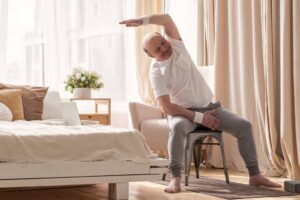Estimated read time: 8 minutes
Aging gracefully isn’t only about looking good, it’s also about feeling good!
One of the best ways to maintain a healthy lifestyle and feel your best as you age is by following an exercise routine that focuses on improving balance, mobility, and strength.
In this blog post, we’re sharing 17 safe and effective exercises that you can do at home on your own or with your home care service caregiver. From balance exercises to strength training exercises, each of the following exercises will help you achieve a happier and healthier you!
1. Standing From a Chair
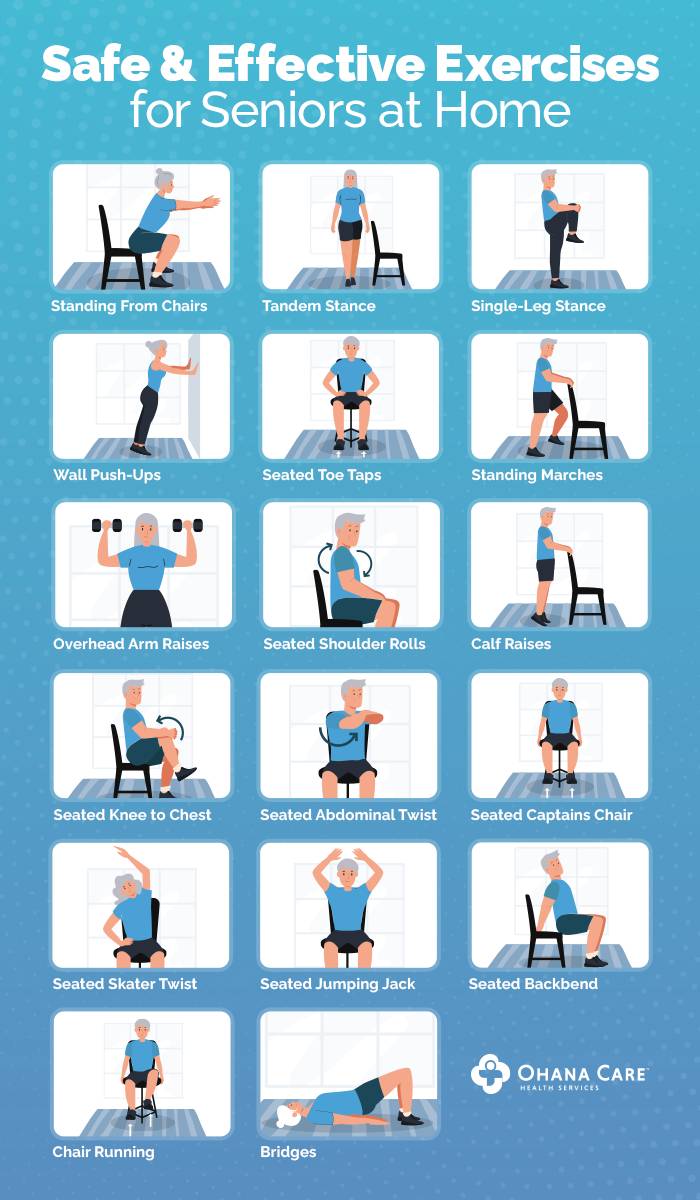
Difficulty: Medium
Standing from chairs is a critical activity for all ages, but it becomes especially challenging as you age due to decreased balance and strength. The best way to strengthen your body is by frequently practicing the sit-to-stand movement.
Here’s how you can do this exercise safely at home:
- Sit up tall in a chair with your feet flat on the floor and shoulder-width apart.
- Shuffle forward in your chair.
- Bring your feet behind your knees for momentum.
- Hinge at your hips and push yourself up.
If you’re struggling with this exercise, you can start by using a taller chair. As you get better at the sit-to-stand movement, try sitting in deeper couches or lower chairs.
2. Tandem Stance
Difficulty: Easy
The tandem stance is a movement that will help you improve balance and stability, which can reduce the risk of injuries and falls. This senior exercise is a simpler version of walking heel to toe and can help you increase strength in your hips, knees, and ankles, which will help you maintain balance.
Follow these instructions and learn how to do the tandem stance correctly:
- Stand with the right side of your body facing the back of a chair.
- With your right arm, grab the back of the chair for support.
- Place your left foot in front of your right foot so you are heel to toe.
- Balance in this position for one minute, then switch sides.
3. Single-Leg Stance
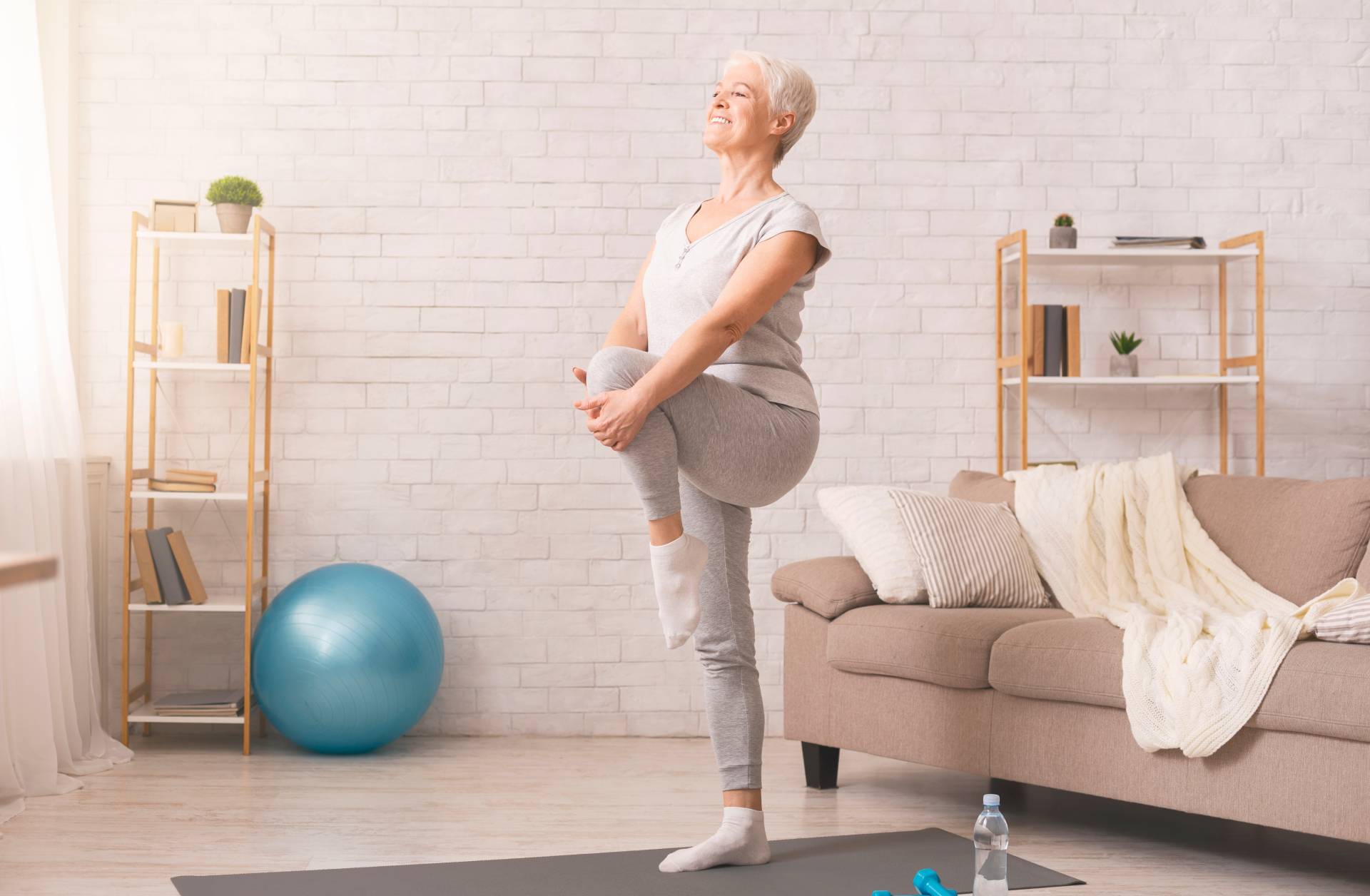
Difficulty: Easy
Like the tandem stance, the single-leg stance is a great exercise that helps improve balance and strengthen your lower body.
Follow these instructions and learn how you can add the single-leg stance to your exercise regime successfully:
- Stand with the left side of your body facing the back of a chair.
- With your left hand, grab the chair for support.
- With your feet shoulder-width apart, lift your left leg off the ground.
- Hold that position for 10 seconds.
- Lower your leg and do the same movement with the opposite leg.
If this exercise is too easy, try to remove your hand from the back of the chair.
4. Wall Push-Ups
Difficulty: Medium
Using your body weight to complete exercises is a great way to build muscle strength without pushing yourself too hard. A safe and effective bodyweight exercise is a wall push-up, which can strengthen your wrists, arms, chest, and abdominal muscles.
Here’s how to do a wall push-up:
- Place your hands on a wall directly in front of you.
- Bend your elbows and slowly lean forward.
- Straighten your arms and push yourself away from the wall.
5. Standing Marches
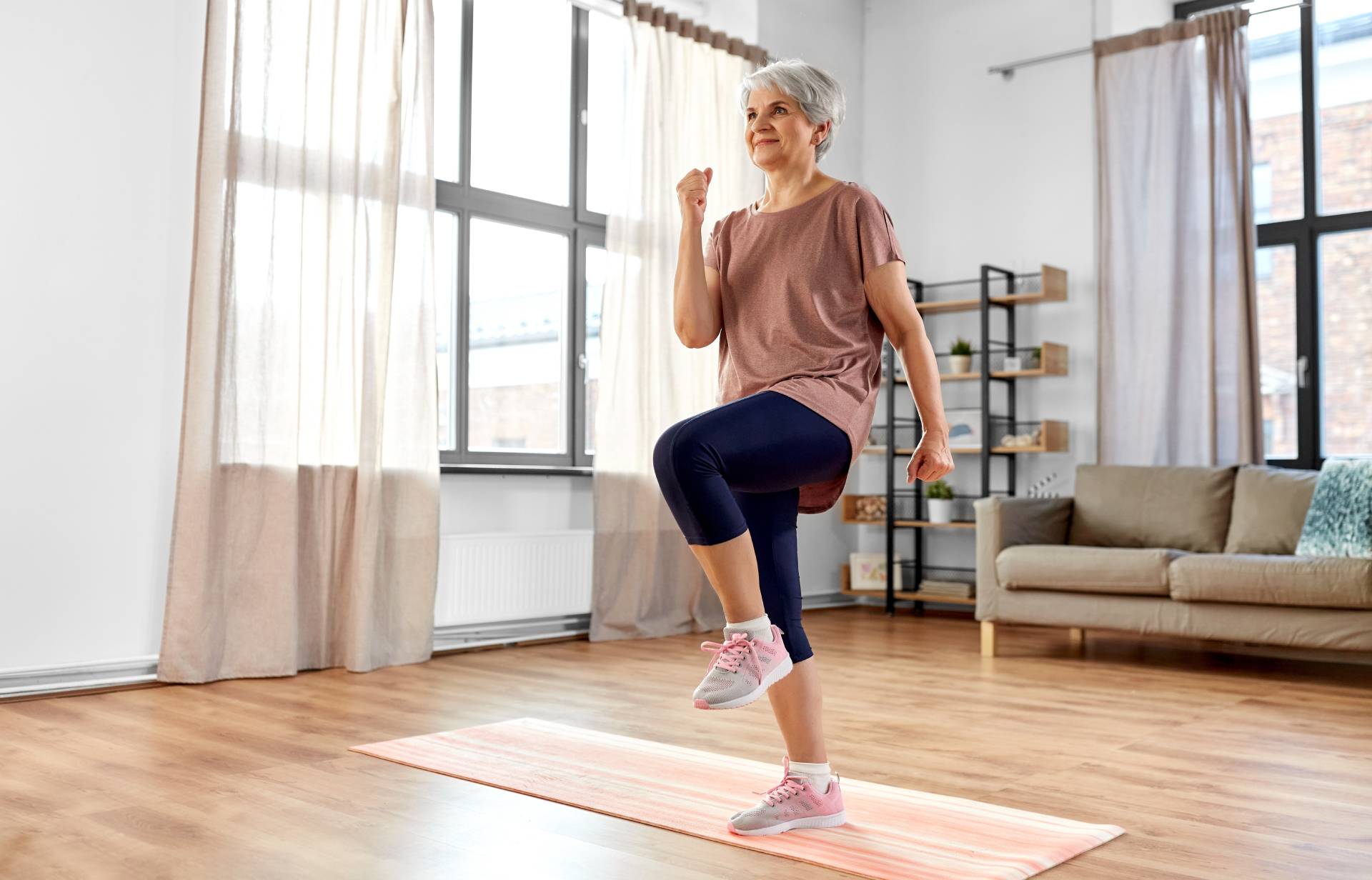
Difficulty: Medium
To increase cardiovascular endurance, balance, and joint mobility, you’ll want to add standing marches to your regular exercise program. These standing marches are low-impact and easy to perform while providing an effective and safe workout.
Here’s how to do standing marches:
- Stand behind a chair and grab the chair for support.
- Stand with your feet slightly apart.
- Bring your right leg up.
- Bring your right leg down while bringing your left leg up.
- Continue lifting your legs back and forth in a marching motion.
- If this exercise is too easy, you can try doing your standing marches without a chair.
6. Seated Toe Taps
Difficulty: Easy
Improve strength, balance, and flexibility with the seated toe taps exercise routine. This exercise focuses on timing and muscle coordination while strengthening ankles, calves, and shins.
Follow these steps to do seated toe taps:
- Sit straight up on a chair with your shoulder blades back.
- Slowly bend your toes so they point to the ceiling.
- Slowly bend your toes so they point down towards the floor.
- Repeat these steps for as long as you can without hurting yourself.
If this exercise is too easy for you, sit on the edge of your chair, make each leg straight, and keep your heels on the floor.
7. Overhead Arm Raises
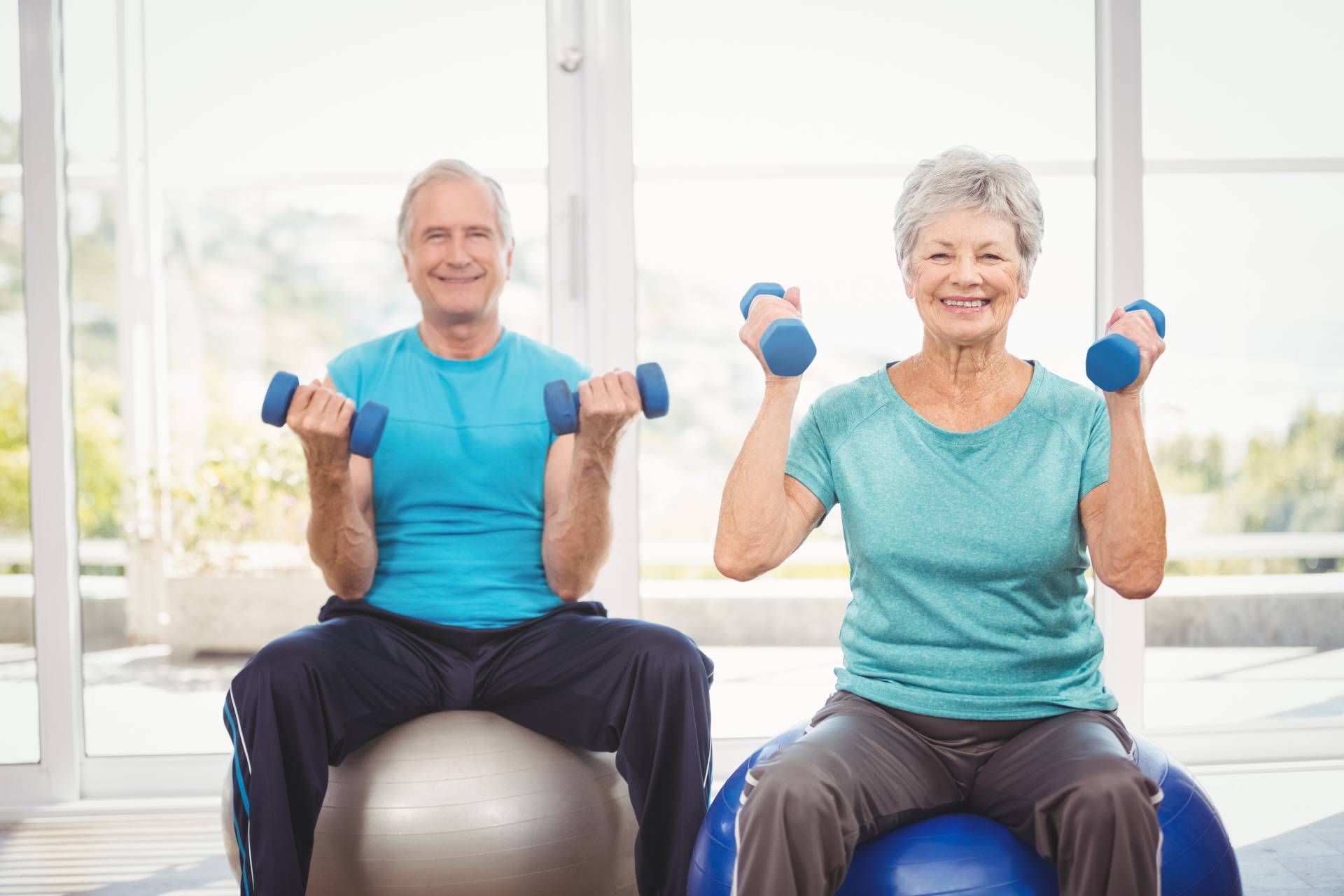
Difficulty: Medium
Strengthen your back, shoulders, and upper arms with overhead arm raises. This safe and controlled movement can improve shoulder mobility and strengthen your arms.
Follow these steps to learn how to do the overhead arm raise exercise correctly:
- Grab a small weight. Feel free to use hand weights or weighted objects like water bottles.
- Lift your arms and open them wide so your elbows align with your shoulders and your hands are above your head.
- Slowly lift your arms until they are in a straight line.
- When you get to the top, hold the position briefly.
- Slowly lower your arms to the starting position.
8. Calf Raises
Difficulty: Easy
Calf raises are a great way to improve your balance, stability, mobility, and circulation in your lower body. Any variation of leg raises, like calf raises, are fantastic for circulation, as when you squeeze your calf muscles, you send blood up from the back of your leg into your heart.
Here are step-by-step instructions on how to do calf raises:
- Stand directly behind a chair.
- Grab the chair for support.
- Stand up nice and tall, keeping your spine straight.
- Come up onto your toes.
- Squeeze your calf muscles for a second.
- Slowly place your heels on the ground.
If you find this exercise easy, incorporate your single-leg stance pose and do the calf raise with one leg off the ground.
9. Seated Shoulder Rolls
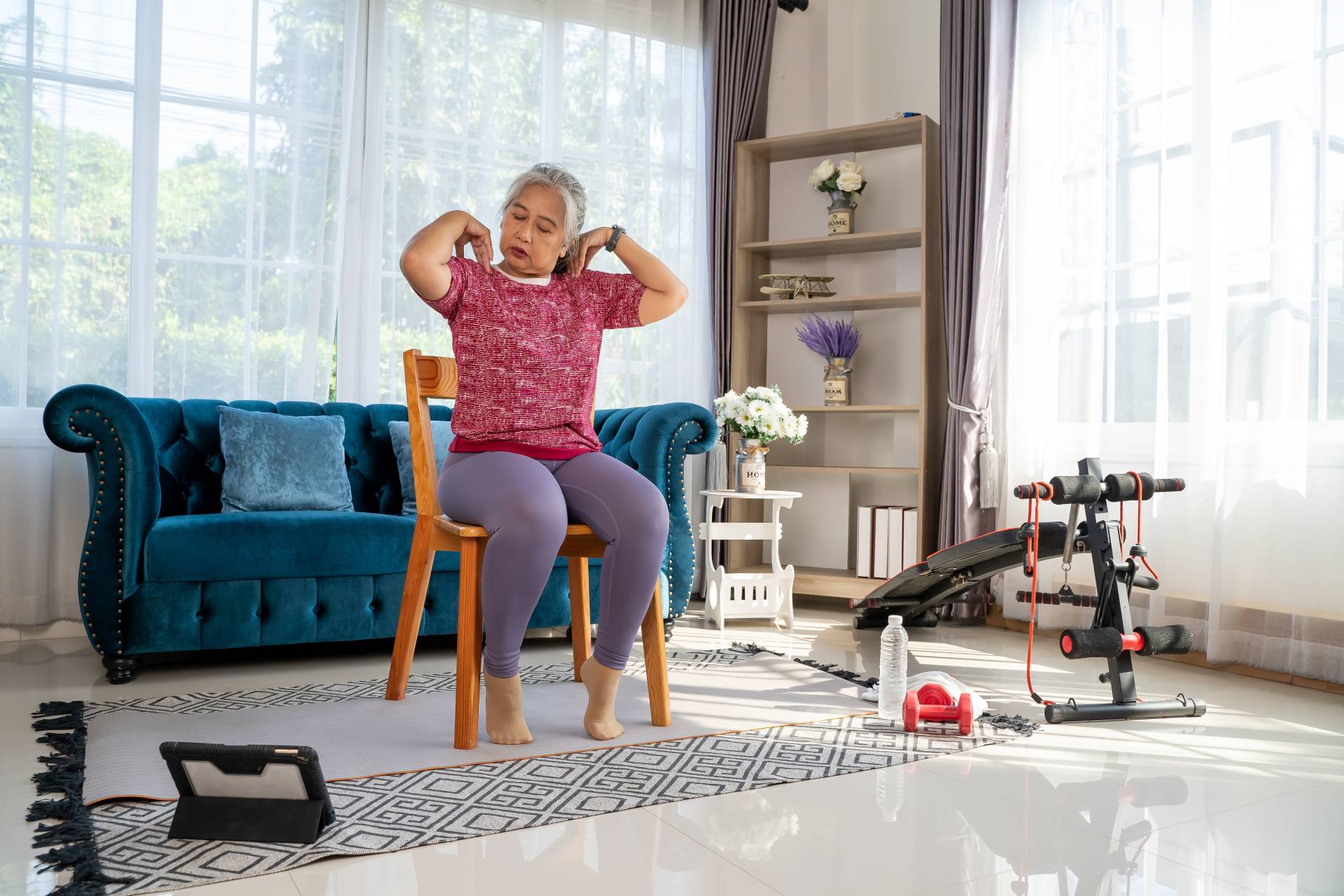
Difficulty: Easy
Shoulder mobility is important for strengthening and stretching your shoulder muscles. By doing shoulder movements, like the seated shoulder roll, you can support joint health while decreasing the risk of injury. Shoulder rolls can be performed sitting or standing.
Here’s how to do the seated shoulder roll:
- Sit upright in a chair.
- Shrug your shoulders so they come up near your ears.
- Slowly rotate your shoulders forward in a circular motion.
- After doing a couple of full rotations, reverse the direction of your rotation.
10. Seated Knee-to-Chest
Difficulty: Medium
The seated knee-to-chest exercise is one of the best exercises for enhancing flexibility and stability while reducing lower back pain. It can help increase the range of motion in your hips, lower back, and legs.
Follow these steps and learn how to do the seated knee-to-chest exercise safely:
- Sit up straight in a chair.
- Keeping your knees bent, bring your left leg up and slowly pull it towards your chest.
- Hold your leg in this position for 20 seconds.
- Gently lower your leg back to the starting position and repeat these steps with the opposite leg.
11. Seated Abdominal Twist
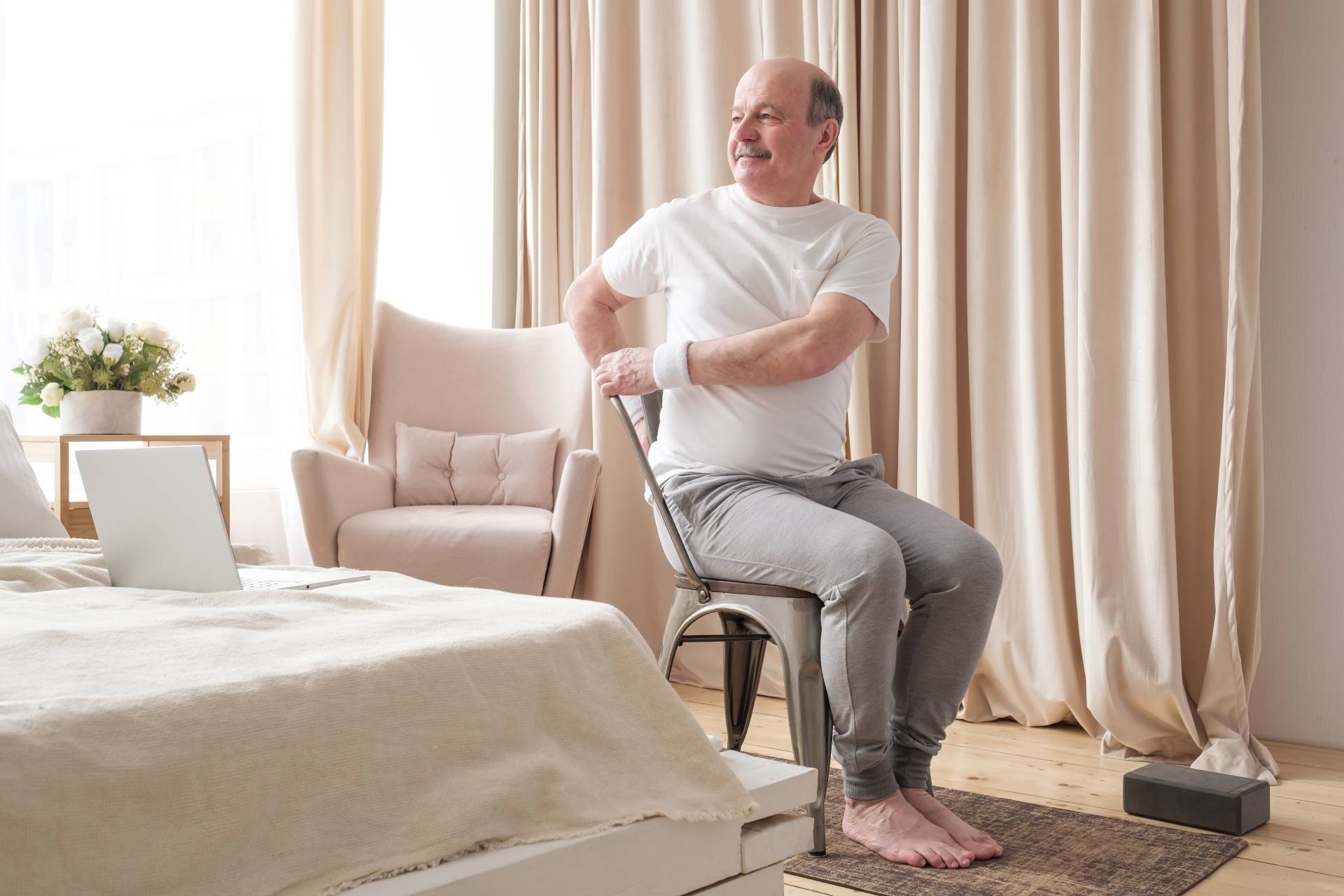
Difficulty: Easy
The seated abdominal twist exercise improves core strength, flexibility, and posture. This movement can also help stimulate digestion!
Here’s how to do the seated abdominal twist safely:
- Sit up straight in a chair.
- Hold your arms at a 90-degree angle with your elbows by your side and your forearms in front of you.
- While keeping your body still and your core tight, slowly rotate your body to the side until you feel a stretch.
- Rotate back to the starting position.
- Keep your core tight and rotate your body to the other side.
12. Seated Captain’s Chair
Difficulty: Hard
If you’re looking to strengthen your core muscles and obliques, the seated captain’s chair is the perfect exercise for you. Strengthening these muscle groups can help you improve your overall core strength and posture, which can help you maintain stability and prevent falls.
Here’s how to do the seated captain’s chair:
- Sit up straight in a chair and grab the edge of your seat.
- Brace your core and slowly lift your feet off of the floor.
- Move your knees towards your chest.
- Squeeze your abs.
- Slowly lower your feet back to the floor.
13. Seated Skater Twist
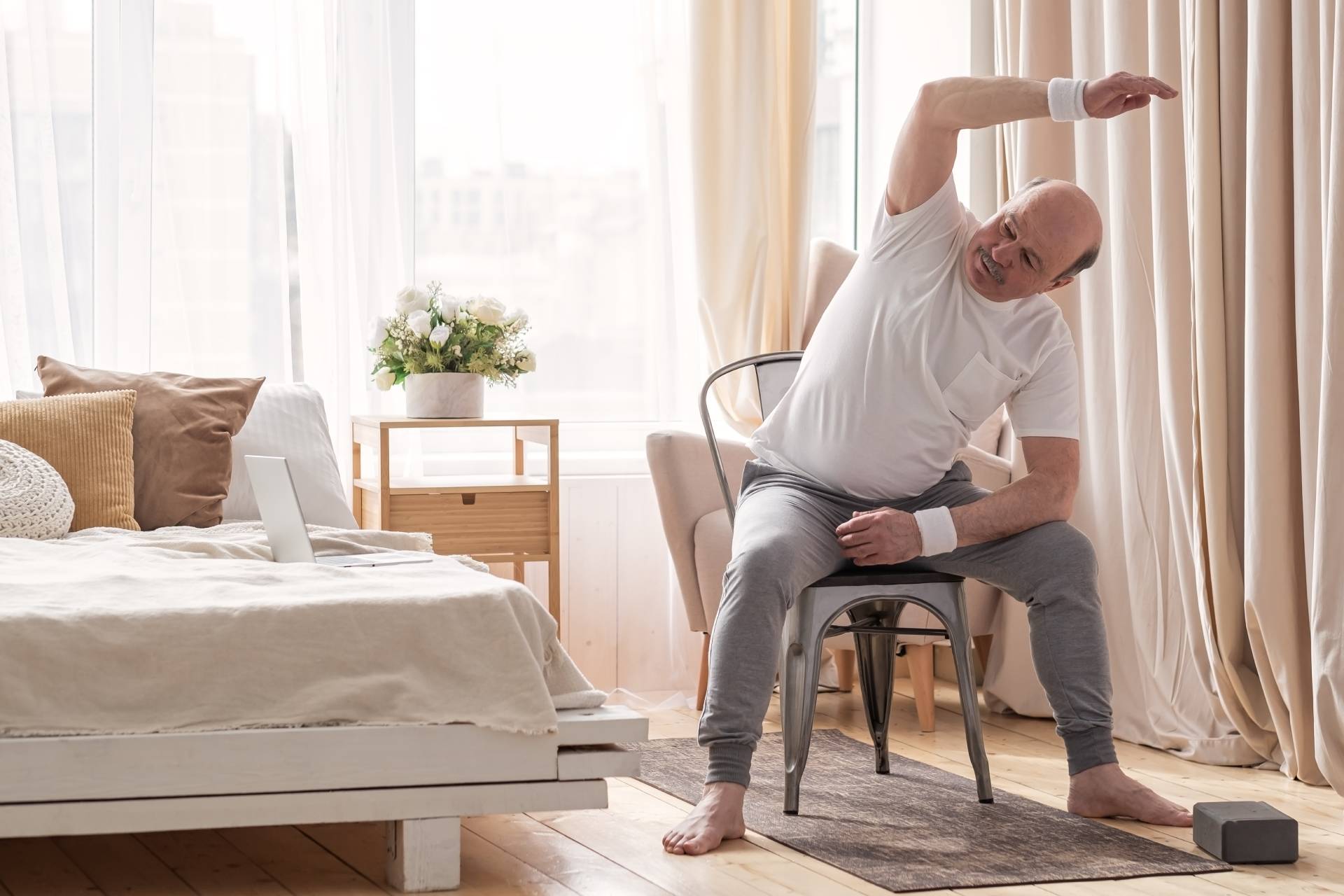
Difficulty: Medium
The seated skater twist is a great exercise for improving coordination, balance, and flexibility. This position can help maintain stability and reduce pain and stiffness in the lower back.
Follow these steps to do the seated skater twist effectively:
- Sit up straight on the edge of a chair.
- Bend your left knee and place your left foot on the floor.
- Reach your right arm to the inside of your left foot.
- Raise your right arm behind your body, twisting at your waist.
- Place your arms back in front of you and straighten your back.
- Follow these steps with your opposite arm and leg.
14. Seated Jumping Jacks
Difficulty: Easy
Along with standing marches, seated jumping jacks are great for improving cardiovascular fitness. This low-impact exercise will help keep your heart healthy and muscles strong while improving your range of motion.
Here’s how to do seated jumping jacks:
- Sit up straight on the edge of a chair.
- Extend both of your arms above your head like you would a normal jumping jack.
- Return your arms to your side.
You can repeat this exercise as many times as you can. If you feel any sort of discomfort or pain, stop the exercise immediately.
15. Seated Backbend
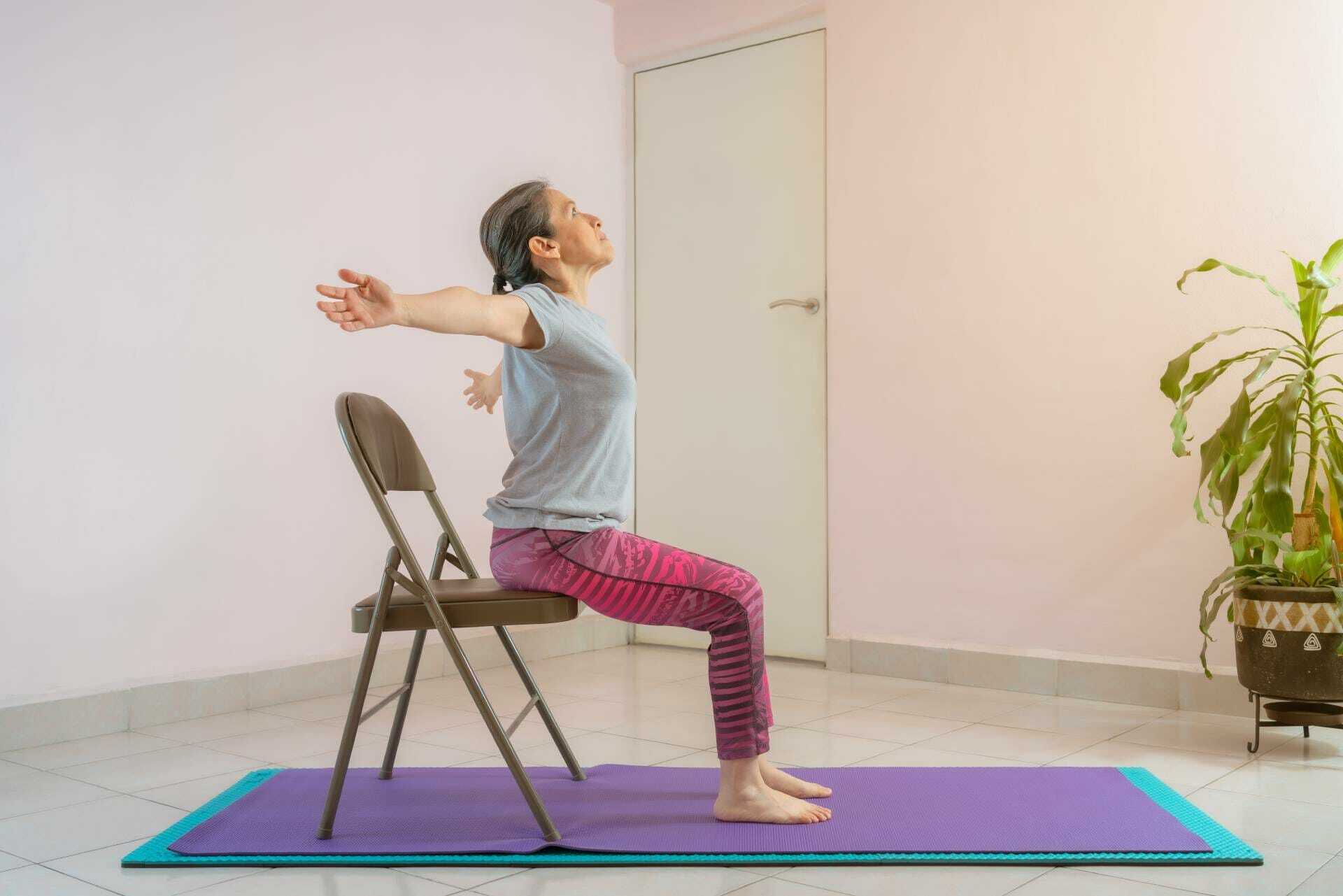
Difficulty: Easy
The seated spinal backbend is a great stretch and exercise with many health benefits. Not only can it enhance flexibility, but it can also:
- Improve posture
- Increase spinal mobility
- Reduce tension
- Stimulate the nervous system
Here’s how to do the seated spinal backbend:
- Sit up straight on the edge of a chair.
- Take the heel of your hands and place them on your lower back.
- Lean back into your hands.
- Stay in this stretch position for a few seconds.
- Slowly bring yourself back up to the starting position.
16. Chair Running
Difficulty: Medium
Chair running is another excellent cardiovascular movement you’ll want to add to your list of exercise routines. If it’s cold outside or you don’t have the opportunity to go on a brisk walk, you can try chair running.
Here’s how to do this movement:
- Sit up straight in a chair.
- Extend your legs and point your toes.
- Slightly lean back so your shoulder blades almost touch the back of the chair.
- Gently lift your feet from the floor.
- Pull your right knee towards your chest while extending the left leg.
- Extend the right knee away from your chest and pull the left leg to your chest.
- Repeat these steps as if you were making a running motion.
17. Bridges
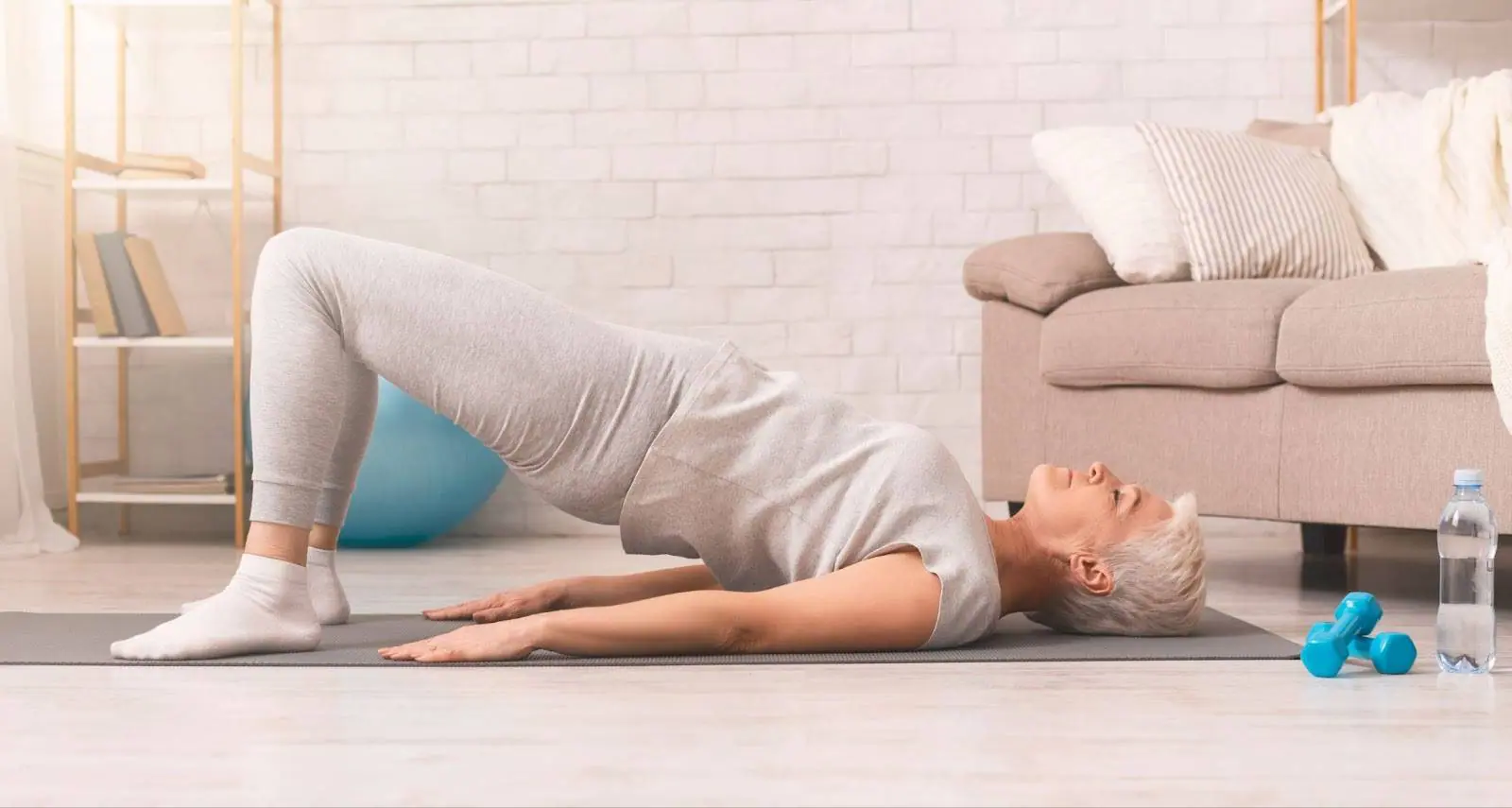
Difficulty: Hard
If you find any of the other exercises easy, you’ll enjoy doing the bridge. The bridge is an exercise that involves you lifting your midsection off of the ground, helping strengthen your lower back and hip extensors. By doing the bridge exercise, you will find getting out of bed, moving furniture, and other types of mobility much easier.
Here’s how to do the bridge exercise:
- Lay down on a comfortable mat. You can lie in the middle of a firm bed if you don’t have a thick yoga mat.
- Bend your knees.
- Raise your hips, squeezing your abdomen and glute muscles.
- Take a pause at the top of the bridge.
- Slowly bring yourself back down.
Stay Healthy With In-Home Exercises
In-home exercises are an effective way for older adults to improve overall physical and mental health.
If you don’t feel 100% confident doing your standing or chair exercises alone, ask a loved one or caregiver to accompany you. They can help ensure you’re doing your exercise regimen safely and effectively, reducing your risk of injury.
At Ohana Care, we have in-home care services in Calgary, Edmonton, and Vancouver that can provide you with support when you need it.
Whether you need companionship care, respite care, or just support when doing your home workouts, you can count on our dedicated team of caregivers.
Make your daily activities easier and your quality of life happier and healthier with Ohana Care. Contact us today to learn more about our in-home care services!
Please consult your doctor before doing any of these exercises. Depending on your mental and physical needs, your doctor may advise different levels of activity.


